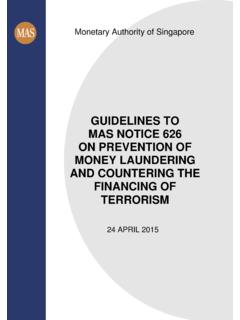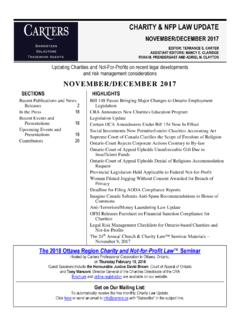Transcription of Breaking the Organized Crime and Counter …
1 Breaking the Organized Crime and Counter - terrorism nexus : identifying programmatic approaches MEETING REPORT. INTRODUCTION. Security Council Resolution 2195 (2014), Threats to international peace and security, called upon states to better understand and address the nexus between Organized Crime and terrorism as a threat to security and development. This resolution comes as the culmination of 15 years of consideration by the United Nations the General Assembly and the Security Council on the interaction of terrorism and cross-border Crime and its impact on international peace and security. In line with this resolution, the United Nations Interregional Crime and Justice Research Institute (UNICRI) and the Thailand Institute of Justice (TIJ) hosted a meeting from 11-13 May 2016, in Bangkok, to examine the nexus between organised Crime and terrorism as a threat to security and development and to define better policy and programmatic responses.
2 The meeting brought together representatives of 15 States and international experts with specialised knowledge of organised Crime and terror groups in a number of different regional contexts. The participants were challenged to review the current evidence basis and conceptual theories around the nexus , to test them against their own areas of expertise, and to draw from their knowledge of lessons learned and best practices to propose a series of programme priorities. SUMMARY OF DISCUSSION. There are a number of challenges in understanding the nexus ' between organised Crime and terrorism , that start initially from defining these concepts, both in theory and in practice. There is no universally agreed definition of organised Crime or of terrorism , which means that there is no definitive means by which to identify their convergences and divergences.
3 In common parlance, however, terrorism is defined via the use of violent acts that are intended to intimidate or coerce a civilian population in order to influence the policy or conduct of a government by intimidation or coercion. The challenge has been to distinguish acts of terrorism from the legitimate struggles of people in situations of insurgency or asymmetrical warfare. Defining organised Crime has been even more profound, given that it encompasses such a wide range of illegal acts, including everything from trafficking to cybercrime. The compromise reached within the framework of the UN Convention on Transnational Organised Crime (UNTOC) was to define an organised criminal group, rather than the act itself: as a structured group of three or more persons, existing for a period of time and acting in concert with the aim of committing one or more serious crimes or offences established in accordance with this Convention, in order to obtain, directly or indirectly, a financial or other material benefit.
4 Security Council Resolution 2195 identified a nexus in which criminal networks and terrorist groups meet, and their objectives, identities and modus operandi overlap. In many theatres, these 1. lines are becoming blurred, particularly in the cases of protracted sectarian or separatist conflicts, and the definitions used by many policy makers to gauge responses are being challenged. Terrorists are benefiting from transnational Organized Crime in some regions, including from the trafficking of arms, persons, drugs, and artefacts and from the illicit trade in natural resources including gold and other precious metals and stones, minerals, wildlife, charcoal and oil, as well as from kidnapping for ransom and other crimes including extortion, and bank robbery.
5 Furthermore, terrorist groups benefiting from transnational Organized Crime may contribute to undermining affected States, specifically their security, stability, governance, social and economic While the interest in the relationship between Organized Crime and terrorism is a relatively new focus of the international community, specialists in the field have developed frameworks depicting Crime -terror relationships; specifically, the Crime -terror continuum theory put forth by Tamara Makarenko and frameworks developed by Louise Shelley. Of note, both Makarenko and Shelley state that there has been a significant transformation in international terrorism since the end of the Cold War, with the decline of state support pushing terrorist organizations to turn to Crime to fund their ideological campaigns.
6 As such, while the Crime -terror nexus is a relatively recent phenomenon, largely taking hold since the 1990's, both of these analysts identify an increasing convergence of the two groups in important ways. Makarenko predominantly analyses the ideological and operational nature of the convergence. She depicts the relationship between Organized Crime and terrorism as a continuum, arguing that a single group can slide up and down the scale depending on the environment in which it operates. The two types of relationships that constitute the major components of the nexus are the formation of alliances between criminal and terrorist organisations (alliances) and use of Crime by terrorist groups as a source of funding (operational).2 However, Makarenko states, the relationship between organised Crime and terrorism has evolved into something more complex.
7 As both criminal and terrorist groups incorporated economic and political capabilities into their remit, many groups lost sight of their original motivations and aims. Makarenko argues that the realisation that economic and political power enhance one another and suggests that groups will increasingly become hybrid organisations. This possibility is increased by the fact that criminal and terrorist groups appear to be learning from one another, and adapting to each other's successes and Louise Shelley refined this thesis by observing that it is insufficient to examine organised Crime and terror groups in isolation, or only in comparison to each other. They also must be understood in terms of the association with the state, and increasingly they are converging to form the Unholy 1.
8 UN Security Council, 2014 available on 2. Makarenko, T. The Crime -Terror Continuum: Tracing the Interplay between Transnational Organised Crime and terrorism , Global Crime , 6(2): 129 145, 2004. 3. Ibid. 2. Trinity' where, through corruption and complicity of state actors, criminal and terrorist groups grow in symbiosis with state In the keynote address to the conference, Mark Shaw5 put forward a third means by which to analyse the nexus between organised Crime and terror groups, based upon their strategic use of violence. He argued that while the use of violence often is used as the defining feature of a terrorist group, in fact organised Crime groups also use violence as a strategic way, and one that is not dissimilar to terrorist groups. Firstly, they use symbolic violence and killing to send messages about local authority and control; secondly that innocent victims often are subject to criminal violence; and finally, like terrorist groups, the goal of organised Crime 's use of violence is often to influence political decision-making around the allocation of resources.
9 The meeting of experts was thus convened to assess the continuum or convergence along four axes: i. Transactional, where there are operational linkages between the groups, such as financing, procurement of arms and control of territory;. ii. Ideologies and aims, where the goals of the group are identified according to their objectives;. iii. Relationship to and nature of the state, where the groups can be assessed upon the degree to which they align with or distinguish themselves from the state; and finally, iv. Strategic use of violence, where the nature and use of violence can be used to analyse the nature of the organised Crime and terrorism nexus . These theoretical approaches and frameworks were applied to a series of regional case studies of specific groups through a series of plenary and break-out group discussions.
10 REGIONAL CONTEXTS. The meeting provided the opportunity for four regional discussions, on Africa; Asia and the Pacific;. the Middle East and North Africa; and Central Asia. Despite the diversity of the individual groups discussed, including Boko Haram and Al Shabaab, ISIS and Al Qaeda, there was a strong degree of consensus and coherence around a set of key issues. Firstly, while collectively, the meeting participants acknowledged that interaction between terrorist and transnational Organized criminal groups is not straightforward, each case is context specific, rooted in historical conditions but constantly evolving. This evolution depends on events 4. Shelley, L. "The Unholy Trinity: Transnational Crime , Corruption, and terrorism ", Brown Journal of International Affairs, 11(2): 101-111, 2005.







